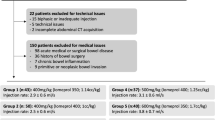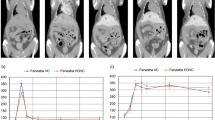Abstract
We have developed a reliable noninvasive method for monitoring colonic tumors and mucosal inflammation in a mouse model of colon cancer using magnetic resonance colonography (MRC). After a mild cleansing enema, the colon is filled with Fluorinert, a perfluorinated liquid that does not produce a proton MR signal. The mouse is placed in a dedicated volume MR receiver coil, and high-resolution images are acquired in three planes. The Fluorinert enema distends the mouse colon, creating an artifact-free black homogeneous background, allowing clear delineation of the inflamed colonic wall and visualization of luminal tumors in various stages of development. A gadolinium-based contrast agent can be administered i.v. to the animal to detect mural inflammation or tumor vascularity. This technique is useful for serial monitoring of the effects of preventive or therapeutic strategies on tumor development without killing the animal or requiring invasive endoscopies. The animal preparation and imaging can be completed in ∼1.5 h.
This is a preview of subscription content, access via your institution
Access options
Subscribe to this journal
Receive 12 print issues and online access
$259.00 per year
only $21.58 per issue
Buy this article
- Purchase on Springer Link
- Instant access to full article PDF
Prices may be subject to local taxes which are calculated during checkout








Similar content being viewed by others
References
Jemal, A., Siegel, R., Xu, J. & Ward, E. Cancer statistics, 2010. CA Cancer J. Clin. 60, 277–300 (2010).
Becker, C., Fantini, M.C. & Neurath, M.F. High-resolution colonoscopy in live mice. Nat. Protoc. 1, 2900–2904 (2006).
Becker, C. et al. In vivo imaging of colitis and colon cancer development in mice using high-resolution chromoendoscopy. Gut 54, 950–954 (2005).
Durkee, B.Y., Weichert, J.P. & Halberg, R.B. Small animal micro-CT colonography. Methods 50, 36–41 (2010).
Pickhardt, P.J. et al. Microcomputed tomography colonography for polyp detection in an in vivo mouse tumor model. Proc. Natl. Acad. Sci. 102, 3419–3422 (2005).
Boll, H. et al. Double-contrast micro-CT colonoscopy in live mice. Int. J. Colorectal Dis. 26, 721–727 (2011).
Krupnick, A.S. et al. Quantitative monitoring of mouse lung tumors by magnetic resonance imaging. Nat. Protoc. 7, 128–142 (2012).
Amundson, S.A. et al. Induction of gene expression as a monitor of exposure to ionizing radiation. Radiat. Res. 156, 657–661 (2001).
Saar, B. et al. Prospective study on bright lumen magnetic resonance colonography in comparison with conventional colonoscopy. Br. J. Radiol. 80, 235–241 (2007).
Ajaj, W. et al. Dark lumen magnetic resonance colonography: comparison with conventional colonoscopy for the detection of colorectal pathology. Gut 52, 1738–1743 (2003).
Zijta, F.M. et al. Feasibility of using automated insufflated carbon dioxide (CO2) for luminal distension in 3.0T MR colonography. Eur. J. Radiol. 81, 1128–1133 (2012).
Keeling, A.N. et al. Intravenous, contrast-enhanced MR colonography using air as endoluminal contrast agent: impact on colorectal polyp detection. Eur. J. Radiol. 81, 31–38 (2012).
Graser, A. Magnetic Resonance colonography. Radiol. Clin. N. Am. 51, 113–120 (2013).
Lauenstein, T.C., Goehde, S.C. & Debatin, J.F. Fecal tagging: MR colonography without colonic cleansing. Abdom. Imaging 4, 410–417 (2002).
Hensley, H.H., Chang, W.C. & Clapper, M.L. Detection and volume determination of colonic tumors in Min mice by magnetic resonance micro-imaging. Magn. Reson. Med. 52, 524–529 (2004).
Melgar, S., Gillberg, P.G., Hockings, P.D. & Olsson, L.E. High-throughput magnetic resonance imaging in murine colonic inflammation. Biochem. Biophys. Res. Commun. 355, 1102–1107 (2007).
Larsson, A.E. et al. Magnetic resonance imaging of experimental mouse colitis and association with inflammatory activity. Inflamm. Bowel Dis. 12, 478–485 (2006).
Herborn, C.U. et al. Dark lumen magnetic resonance colonography in a rodent polyp model: initial experience and demonstration of feasibility. Invest. Radiol. 39, 723–727 (2004).
Breynaert, C. et al. Unique gene expression and MR T2 relaxometry patterns define chronic murine dextran sodium sulphate colitis as a model for connective tissue changes in human Crohn's disease. PLoS ONE 8, e68876 (2013).
Young, M.R. et al. Monitoring of tumor promotion and progression in a mouse model of inflammation-induced colon cancer with magnetic resonance colonography. Neoplasia 11, 237–246 (2009).
Tanaka, T. et al. A novel inflammation-related mouse colon carcinogenesis model induced by azoxymethane and dextran sodium sulfate. Cancer Sci. 94, 965–973 (2003).
Neufert, C., Becker, C. & Neurath, M.F. An inducible mouse model of colon carcinogenesis for the analysis of sporadic and inflammation-driven tumor progression. Nat. Protoc. 2, 1998–2004 (2007).
Saud, S. et al. Chemopreventive activity of plant flavonoid isorhamnetin in colorectal cancer is mediated by oncogenic Src and β-catenin. Cancer Res. 73, 5473–5484 (2013).
Miller, S.J. et al. Multimodal imaging of growth and rapamycin-induced regression of colonic adenomas in Apc mutation–dependent mouse. Transl. Oncol. 5, 313–320 (2012).
Quarles, C.C. et al. Functional colonography of Min mice using dark lumen dynamic contrast-enhanced MRI. Magn. Reson. Med. 60, 718–726 (2008).
Flaim, S.F. Pharmacokinetics and side effects of perfluorocarbon-based blood substitutes. Artif. Cells Blood Substit. Immobil. Biotechnol. 22, 1043–1054 (1994).
Chu, S.J. et al. Systemic administration of FC-77 dampens ischemia-reperfusion-induced acute lung injury in rats. Inflammation 36, 1383–1392 (2013).
Chang, H. et al. Intravascular FC-77 attenuates phorbol myristate acetate-induced acute lung injury in isolated rat lungs. Crit. Care Med. 36, 1222–1229 (2008).
Zhu, Y.B. et al. Partial liquid ventilation decreases tissue and serum tumor necrosis factor-α concentrations in acute lung injury model of immature piglet induced by oleic acid. Chin. Med. J. (Engl) 125, 123–128 (2012).
Hirayama, Y. et al. Partial liquid ventilation with FC-77 suppresses the release of lipid mediators in rat acute lung injury model. Crit. Care Med. 32, 2085–2089 (2004).
Maevsky, E., Ivanitsky, G. & Bogdanova, L. Clinical results of Perftoran application: present and future. Artif. Cells Blood Substit. Immobil. Biotechnol. 33, 37–46 (2005).
Kaneda, M.M., Caruthers, S., Lanza, G.M. & Wickline, S.A. Perfluorocarbon nanoemulsions for quantitative molecular imaging and targeted therapeutics. Ann. Biomed. Eng. 37, 1922–1933 (2009).
Giraudeau, C. et al. 19F molecular MR imaging for detection of brain tumor angiogenesis: in vivo validation using targeted PFOB nanoparticles. Angiogenesis 16, 171–179 (2013).
Liao, A.H. et al. Evaluation of 18F-labeled targeted perfluorocarbon-filled albumin microbubbles as a probe for micro-US and micro-PET in tumor-bearing mice. Ultrasonics 53, 320–327 (2013).
Turkbey, B. et al. Is apparent diffusion coefficient associated with clinical risk scores for prostate cancers that are visible on 3-T MR images? Radiology 258, 488–495 (2011).
Turkbey, B. et al. Documenting the location of systematic transrectal ultrasound-guided prostate biopsies: correlation with multi-parametric MRI. Cancer Imaging 11, 31–36 (2011).
Acknowledgements
This project has been funded in whole or in part with federal funds from the National Cancer Institute, US National Institutes of Health, under contract HHSN261200800001E. The content of this publication does not necessarily reflect the views or policies of the Department of Health and Human Services, nor does mention of trade names, commercial products or organizations imply endorsement by the US Government.
Author information
Authors and Affiliations
Contributions
L.V.I. performed the MRC experiments and prepared the manuscript; M.B. designed the imaging protocol, assembled the imaging tools, reconstructed and described the fly-through movie and edited the manuscript; M.R.Y. designed the animal study and edited the manuscript; L.A.R. provided animal support; J.L.T. advised and discussed on the imaging methods; J.D.K. supervised the project and edited the manuscript; P.L.C. developed the project concept and edited the manuscript.
Corresponding author
Ethics declarations
Competing interests
The authors declare no competing financial interests.
Integrated supplementary information
Supplementary Figure 1 MRI equipment setup.
(a) Philips Achieva 3.0T clinical scanner; (b) Mouse solenoid receiver coil with plastic chamber; (c) Mouse imaging bed; and (d) Syringe pumps for contrast media and enema infusion.
Supplementary information
Supplementary Figure 1
MRI equipment setup. (PDF 270 kb)
Fly-through movie.
The 3D image data allow reconstruction of a virtual colonoscopy fly-through movie that enables tumor search inside the walls of the colon. Refer to Box 2 for advice on how to do this. (MOV 9631 kb)
Rights and permissions
About this article
Cite this article
Ileva, L., Bernardo, M., Young, M. et al. In vivo MRI virtual colonography in a mouse model of colon cancer. Nat Protoc 9, 2682–2692 (2014). https://doi.org/10.1038/nprot.2014.178
Published:
Issue Date:
DOI: https://doi.org/10.1038/nprot.2014.178
Comments
By submitting a comment you agree to abide by our Terms and Community Guidelines. If you find something abusive or that does not comply with our terms or guidelines please flag it as inappropriate.



